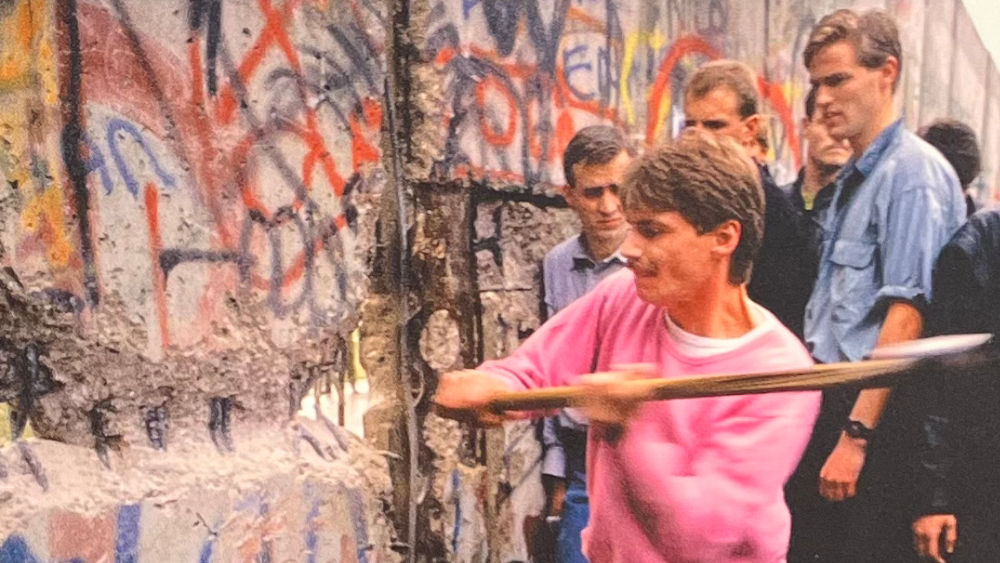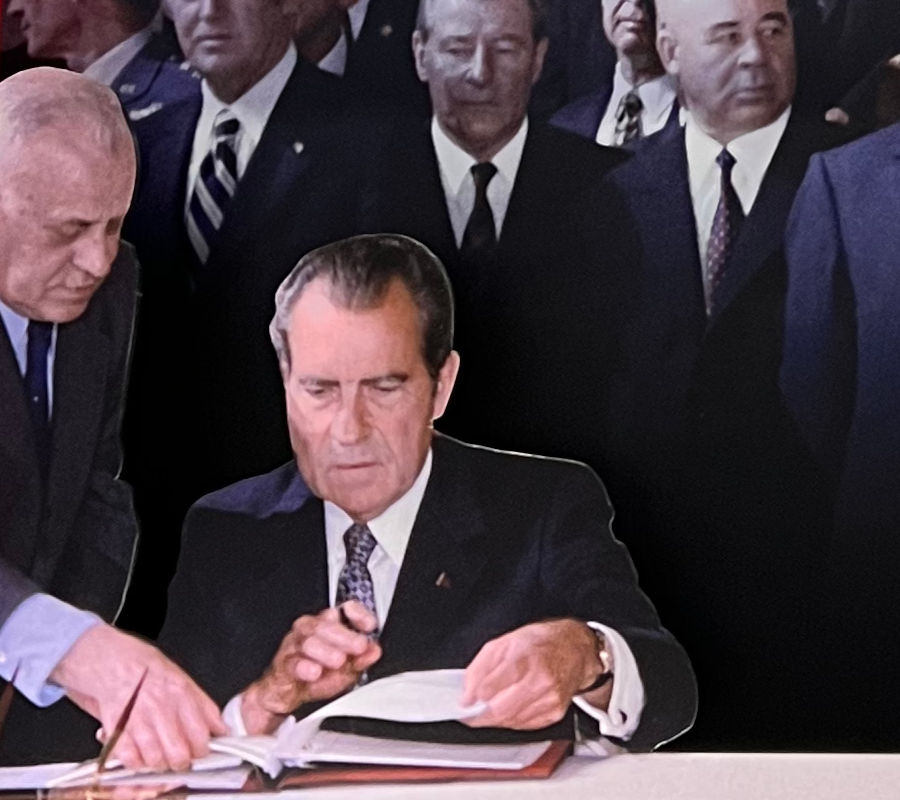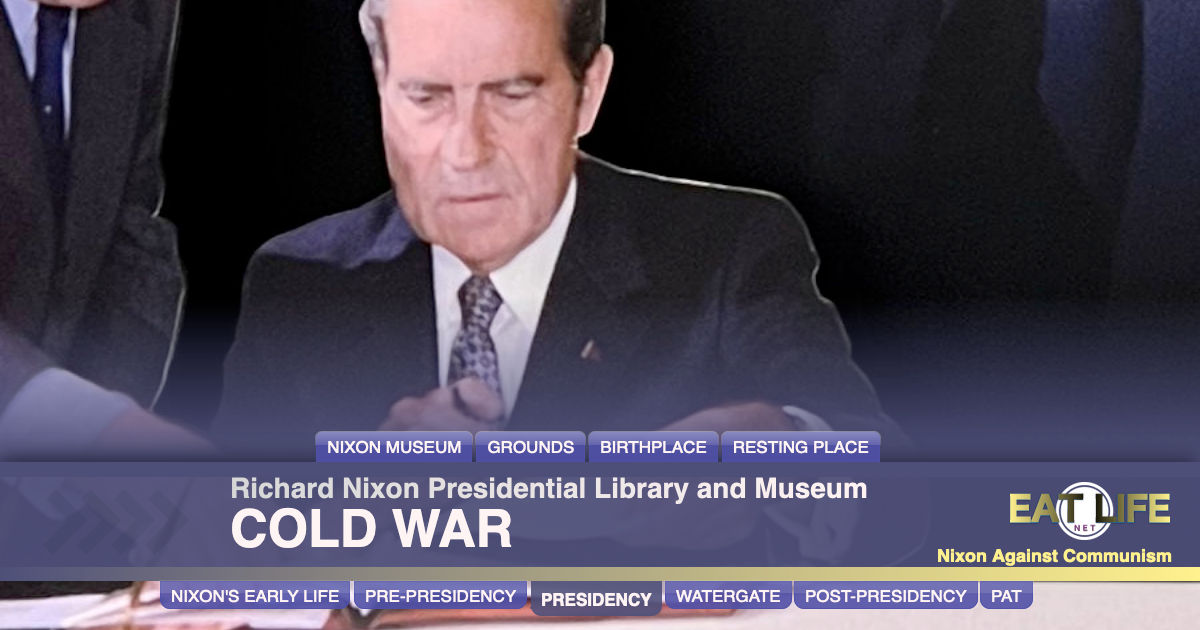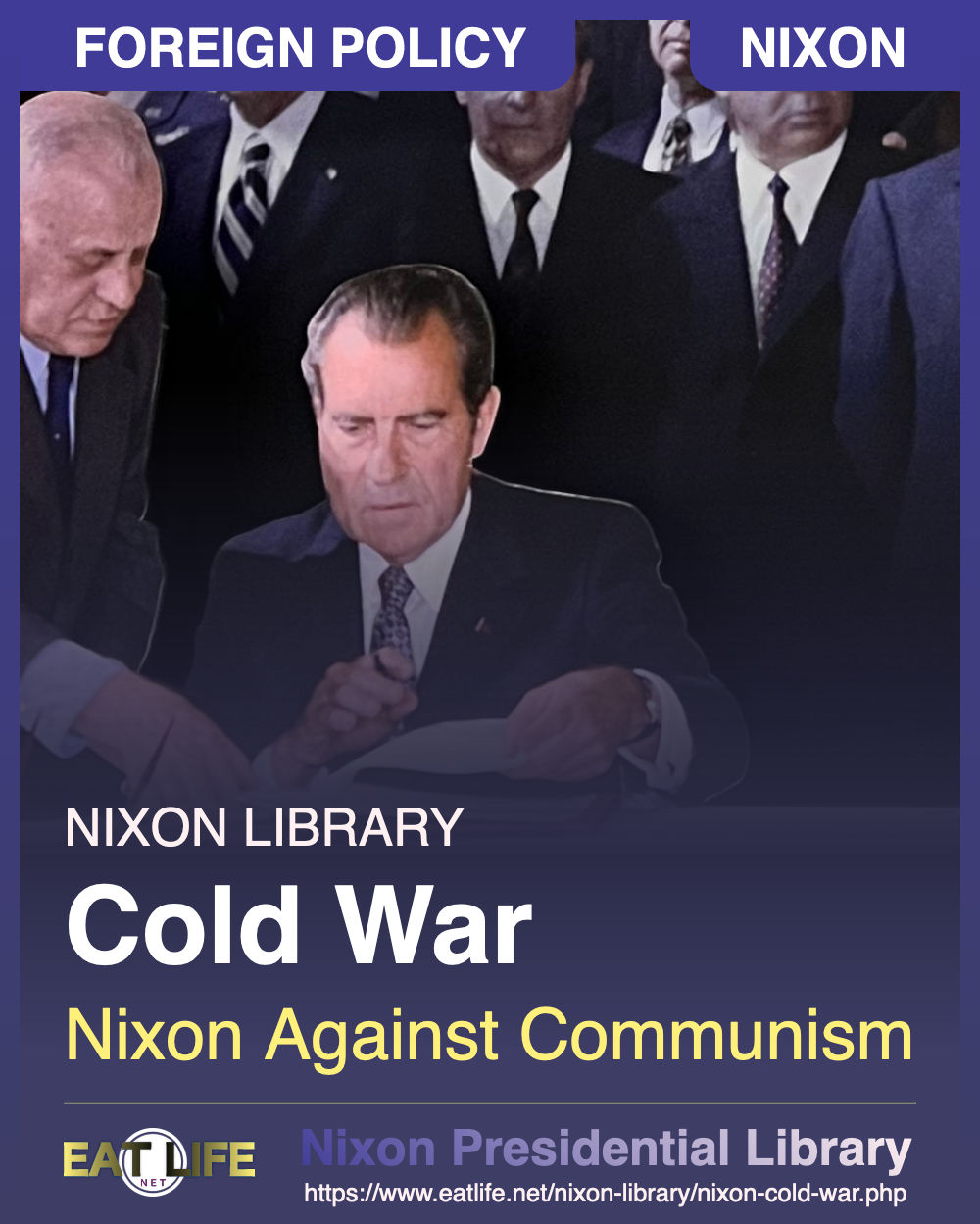The Cold War began when the alliance between the U.S. and the U.S.S.R. fractured after World War Il and both great powers armed themselves against the possibility of all-out nuclear war.
By the time Nixon became President, tensions had cooled from the high-stakes Cuban Missile Crisis in 1962, but every aspect of foreign policy was colored by whether a nation was allied with the United States or the Soviet Union.
Richard Nixon had earned a reputation throughout his career for being tough on communism, both at home and abroad. As President, he tempered that tough stance with a broader view of the global balance of power.
The major problem confronting the people of the United States and free peoples everywhere in the last half of the 20th century is the threat to peace and freedom presented by the militant aggressiveness of international communism. ー August 1960
But the spread of communism in Europe and Latin and South America posed a threat to American interests and principles. President Nixon responded to those threats through different kinds of action, although with mixed results.
- Cuba:
Early in his Presidency Nixon ordered the CIA to step up its covert operations there. Confrontation threatened in 1970 when the U.S. discovered Soviet expansion of a naval base at Cienfuegos. Nixon relied on diplomacy to get the Soviets to agree that no nuclear submarines would dock there and tensions calmed. - Chile:
In November 1970, after a close three-way race, Salvador Allende became Chile's first Marxist President. Amidst increasing unrest and the declaration of a "constitutional crisis in which Chile's Supreme Court publicly opposed the Allende government," Nixon directed the CIA to undermine Allende's position. A CIA-supported military coup in September 1973 culminated in Allende's ouster and death. Allende's government was followed by the brutal dictatorial regime of Augusto Pinochet. - Eastern Europe:
In 1969 Nixon became the first President to visit a Soviet bloc country when he traveled to Romania. This visit opened doors to talks with the North Vietnamese and to early contacts with China. It also formed the foundation for trade deals Nixon would develop with Romania and Yugoslavia.
The sunken sub presented a tempting prize, offering the possibility of information on Soviet technology and codes that could be used to translate intercepted intelligence. In 1970, President Nixon authorized secret efforts to recover the sub.
In 1974 the Glomar Explorer, supposedly mining manganese nodules from the ocean floor, stationed itself in the Pacific. Equipped with a large mechanical claw, the salvage ship began to raise the sub. An equipment failure led to two-thirds of the sub sinking back to the ocean floor.
The mission recovered the bodies of six crew members, along with nuclear torpedoes and other materials. Although Project Azorian was not a complete success, it remains the deepest salvage operation ever conducted and is considered one of the greatest intelligence coups of the Cold War.
The story first broke the following year, but significant declassification of the details would have to wait until 2010.
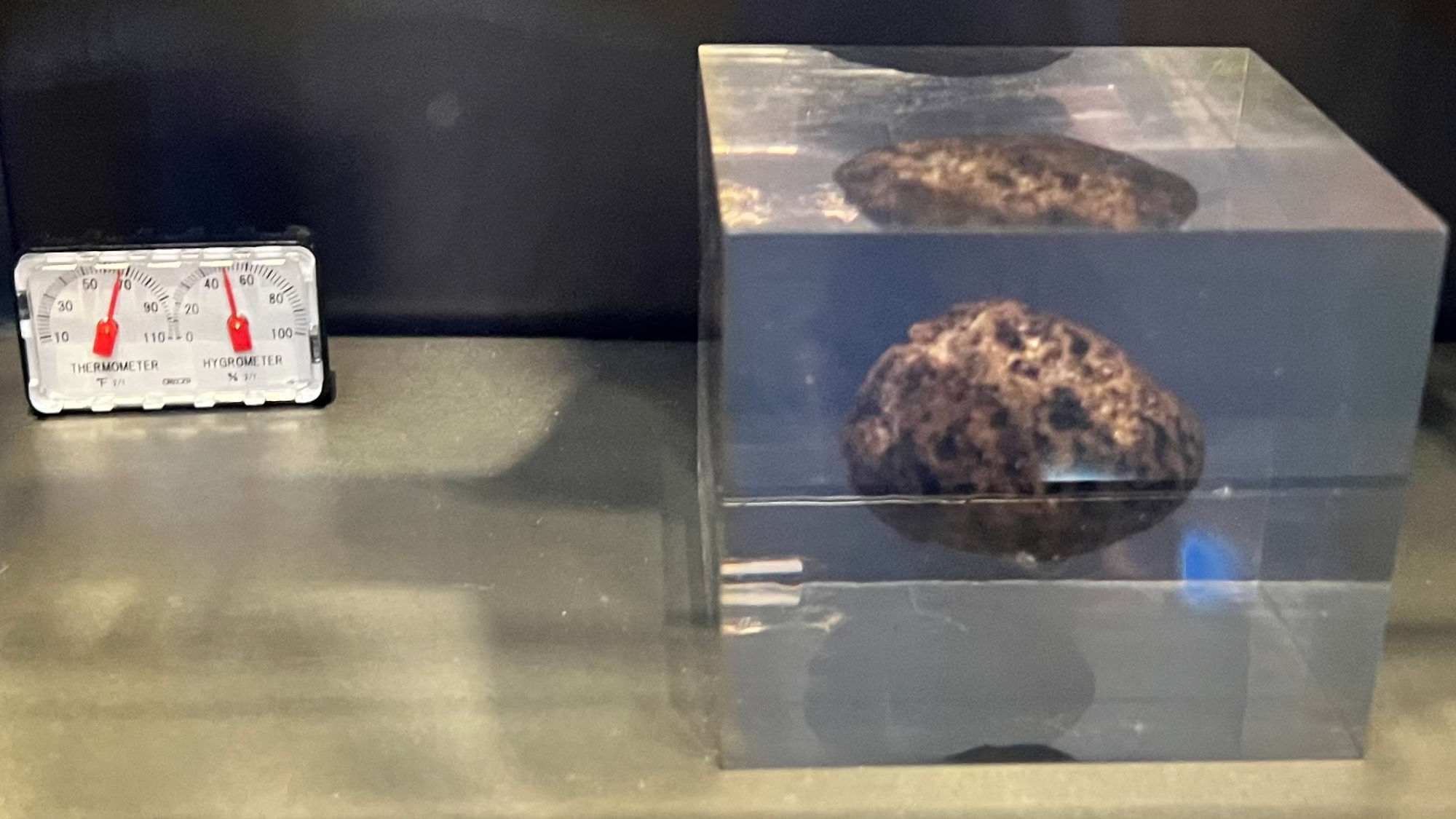
Manganese Nodules Encased in Lucite
- Gathered by the Glomar Explorer during its attempt to recover a sunken Soviet submarine in 1974.
President Nixon initiated the Strategic Arms Limitation Talks soon after he took office in 1969. After nearly three years of negotiations, the treaty known as SALT I was finally signed in Moscow in May 1972.
- The SALT treaty is seen as one of Nixon's great accomplishments. SALT limited the number of nuclear arms each nation could possess - and was a first step in the long process of defusing the threat of nuclear war.
We shall continue, in this era of negotiation, to work for the limitation of nuclear arms and to reduce the danger of confrontation between the great powers.
- Senator Edmund Muskie, October 17, 1969
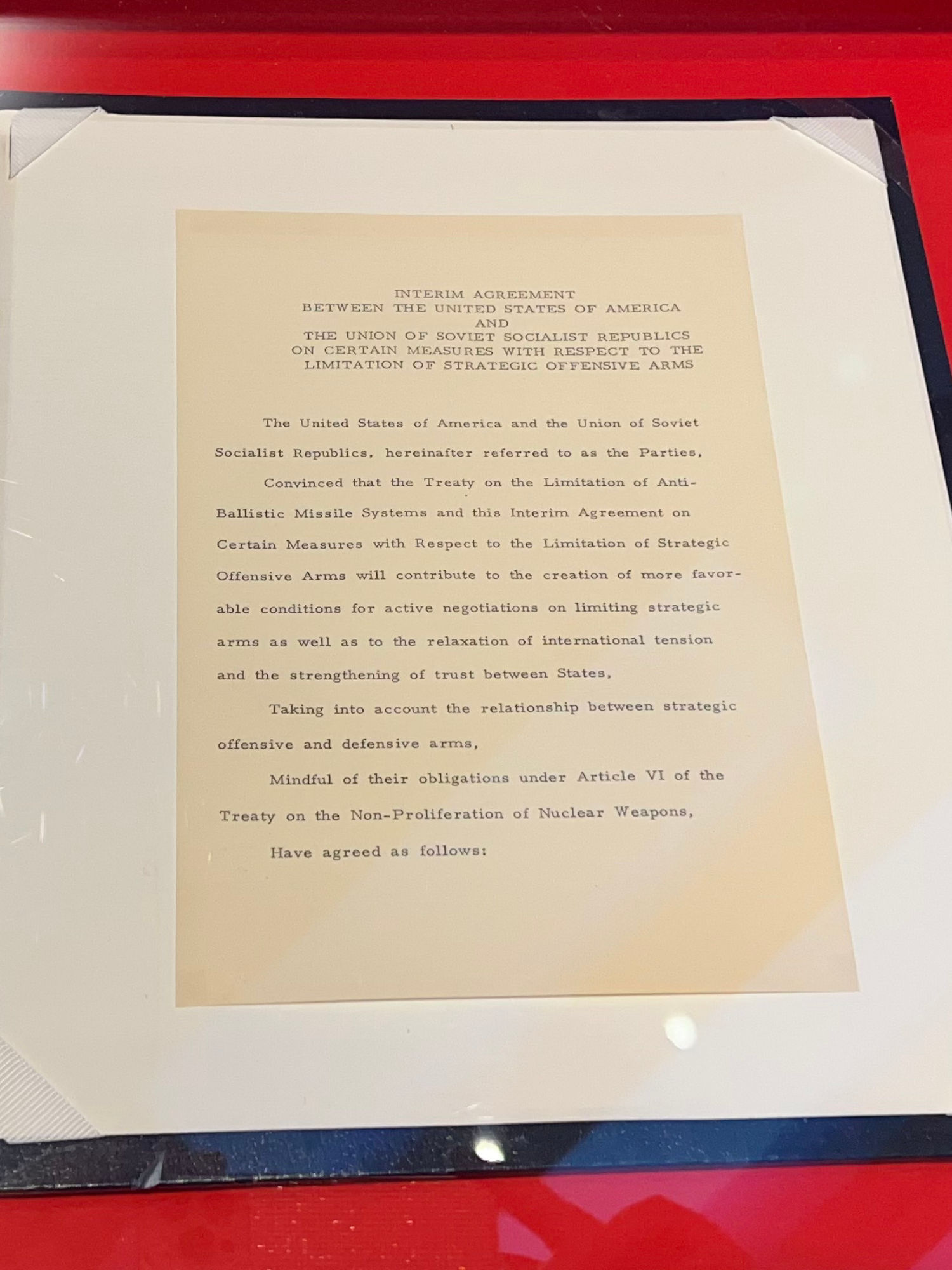
S.A.L.T. Treaty (facsimile)
- President Nixon and General Secretary Brezhnev signed the interim Strategic Arms Limitation Talks agreement (SALT 1) in Moscow on May 26, 1972.
Interim Agreement Between The United States of America and The Union of Soviet Socialist Republics on Certain Measures With Respect to the Limitation of Strategic Offensive Arms
The United States of America and the Union of Soviet Socialist Republics, hereinafter referred to as the Parties,
Convinced that the Treaty on the Limitation of Anti-Ballistic Missile Systems and this Interim Agreement on Certain Measures with Respect to the Limitation of Strategic Offensive Arms will contribute to the creation of more favorable conditions for active negotiations on limiting strategic arms as well as to the relaxation of international tension and the strengthening of trust between States,
Taking into account the relationship between strategic offensive and defensive arms,
Mindful of their obligations under Article VI of the Treaty on the Non-Proliferation of Nuclear Weapons,
Have agreed as follows:
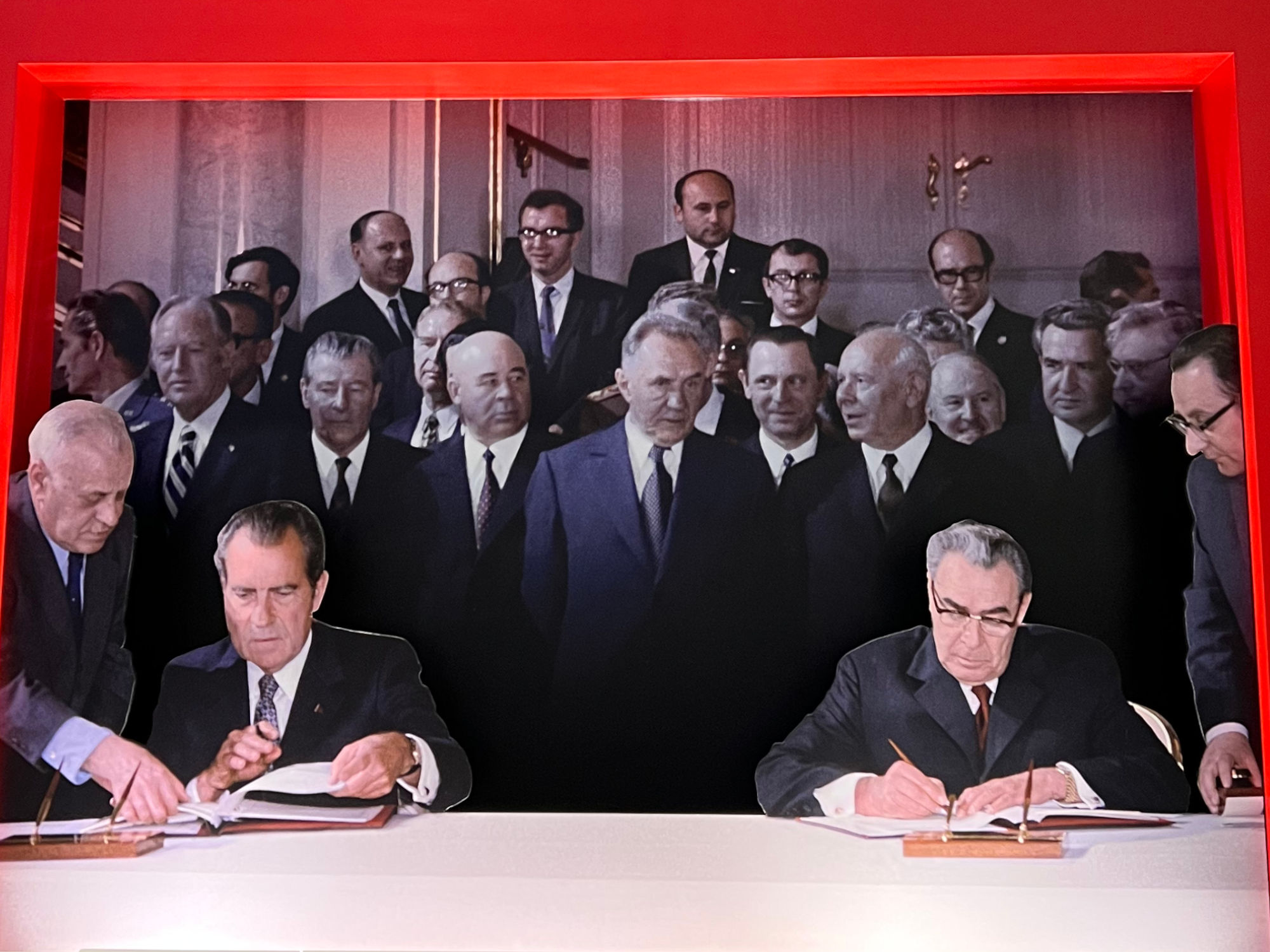
S.A.L.T. Treaty
- June 26, 1972 - President Nixon and General Secretary Leonid Brezhnev sign the first Strategic Arms Limitation Treaty (SALT I) in St. Vladimir's Hall in the Grand Kremlin Palace.
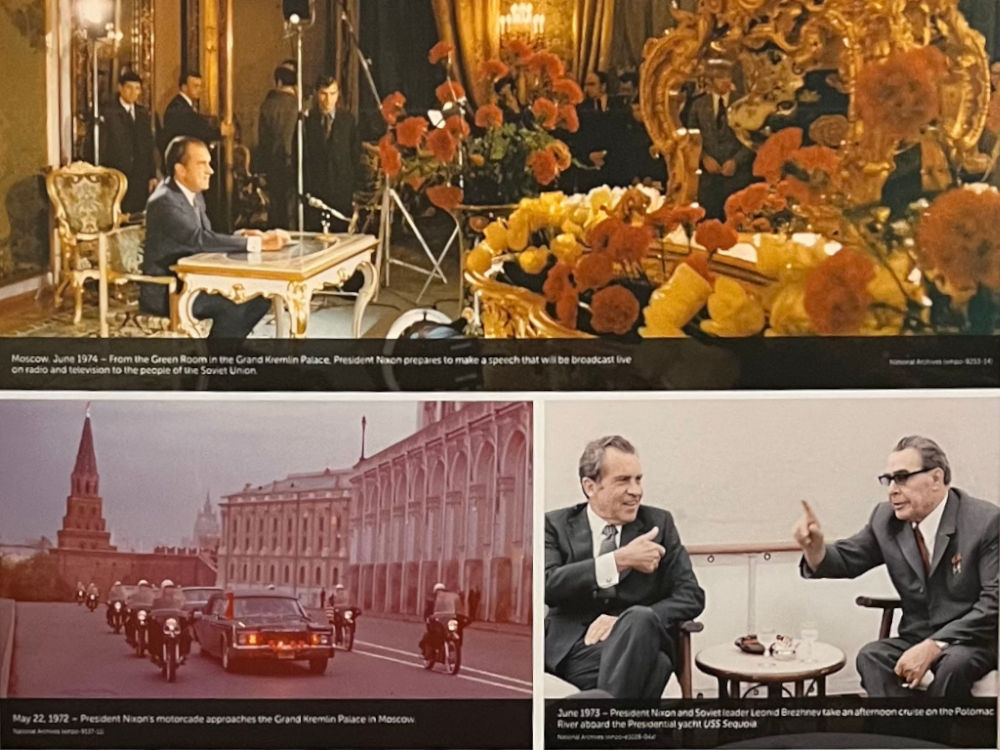
Back in the USSR
- From the Green Room in the Grand Kremlin Palace, President Nixon prepares to make a speech that will be broadcast live on radio and television to the people of the Soviet Union - June 1974, Moscow
- President Nixon's motorcade approaches the Grand Kremlin Palace in Moscow - May 22, 1972
- President Nixon and Soviet leader Leonid Brezhnev take an afternoon cruise on the Potomac River aboard the Presidential yacht USS Sequoia - June 1973
This summit was an essential element of Nixon's policy of detente, which meant a thawing or easing or the strained relations between the two nations.
Since the end of World War II, American Presidents had sought military superiority over the Soviet Union. Nixon made clear from the beginning of his administration that he would aim for sufficiency rather than superiority. Sufficiency meant having enough resources to deter attacks and defend the United States and its interests and allies.
At the 1972 summit, Nixon and Brezhnev signed treaties limiting their two nations' numbers of strategic arms and ending the development of anti-ballistic missiles.
Building on the successful Moscow Summit, Brezhnev visited the United States in 1973. He met with Nixon at the White House, at Camp David, and at La Casa Pacifica, the President's "Western White House."
Nixon returned to the Soviet Union in 1974 for more discussions on further developing the new relationship between the two nations.
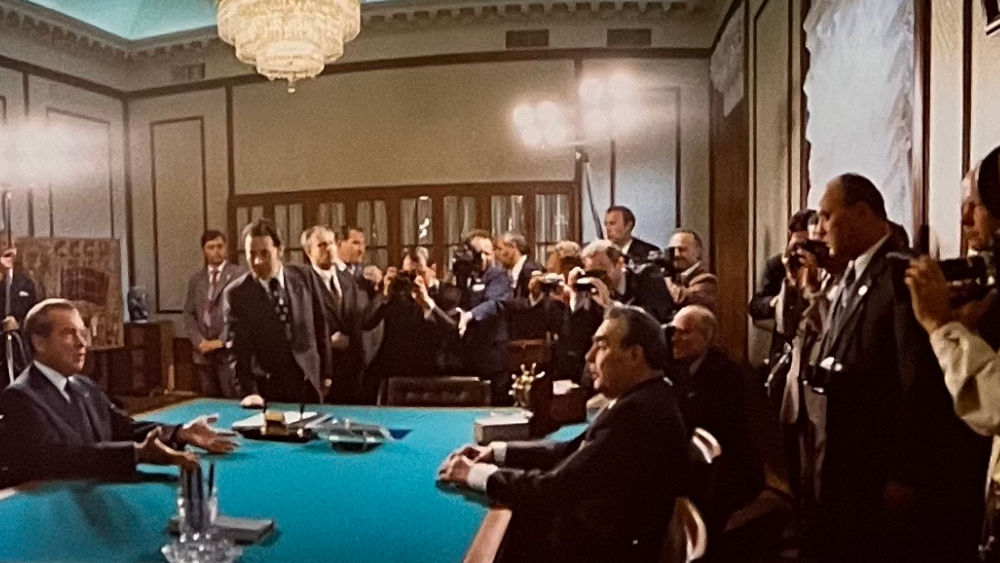
Third Soviet Summit
- At the end of the Third Soviet Summit, Nixon and Brezhnev sign cooperative agreements in areas including energy, housing, and scientific research - June 28, 1974, Moscow
We believe deeply in our ideas but we believe they should travel on their own power and not on the power of our arms. We shall never be belligerent. But we shall be as firm in defending our system as they are in expanding theirs. - August 1968
These selected documents illustrate some of the different strategies and tactics President Nixon and his administration employed in shaping the U.S. relationship with communist countries.
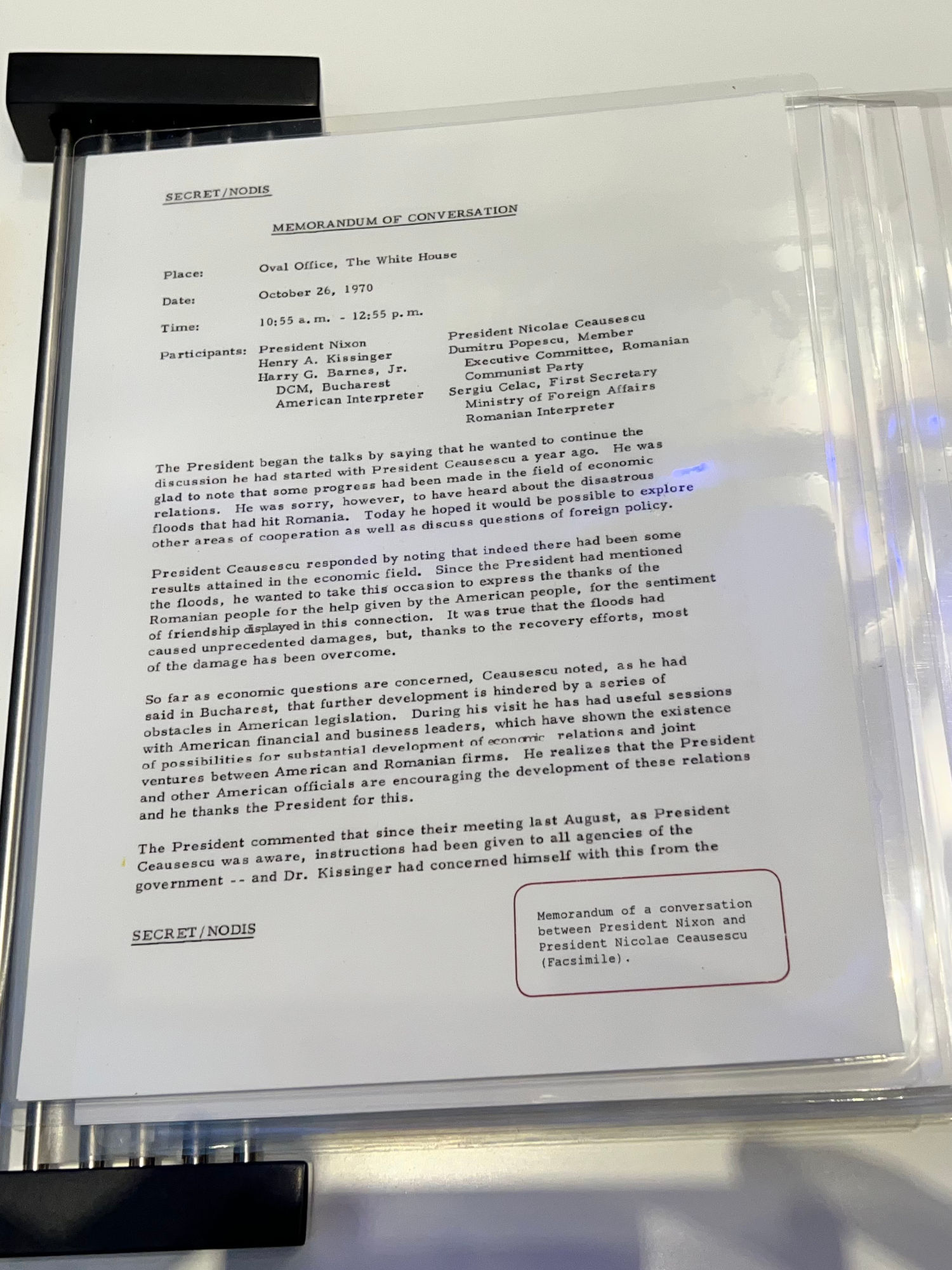
Romania
- Memorandum of a conversation between President Nixon and President Nicolae Ceausescu (Facsimile)
These pages highlight Nixon's use of economic cooperation with Romania and demonstrate how Nixon used the U.S. relationship with Romania to send messages as part of his strategy to open relations with China.
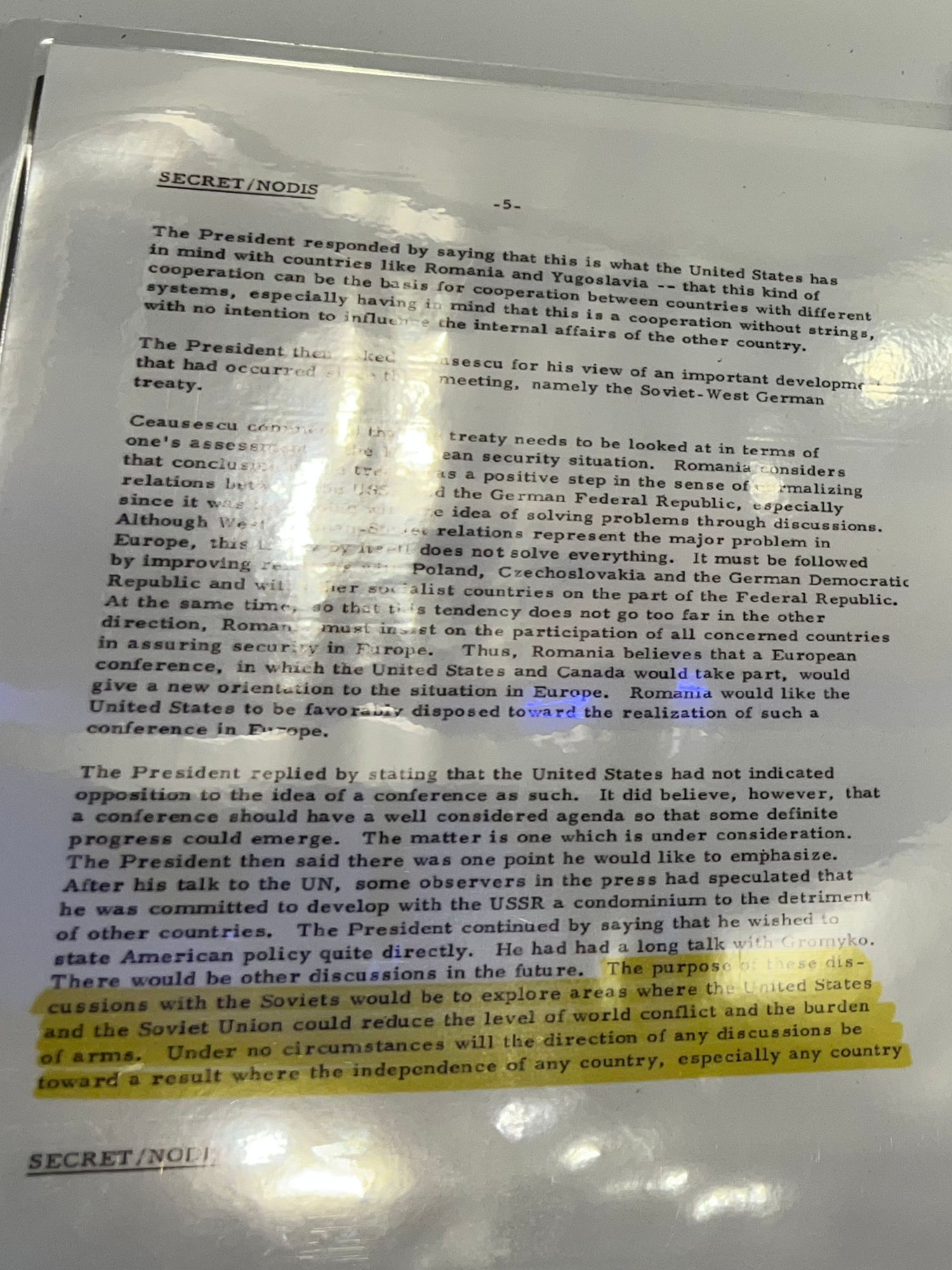
Romania
... The purpose of these discussions with the Soviets would be to explore areas where the United States and the Soviet Union could reduce the level of world conflict and the burden of arms. Under no circumstances will the direction of any discussions be toward a result where the independence of any country, especially any country
in Eastern or Western Europe will be compromised. The future of each country in Europe must be determined by itself not by the USSR nor by the United States.
That is why we will continue, the President added, in the future to attempt to explore ways we can talk with the Peoples' Republic of China again because it is necessary to have avenues of communication with all nations in the world if we are going to have a world safe from the danger of a nuclear war.
...
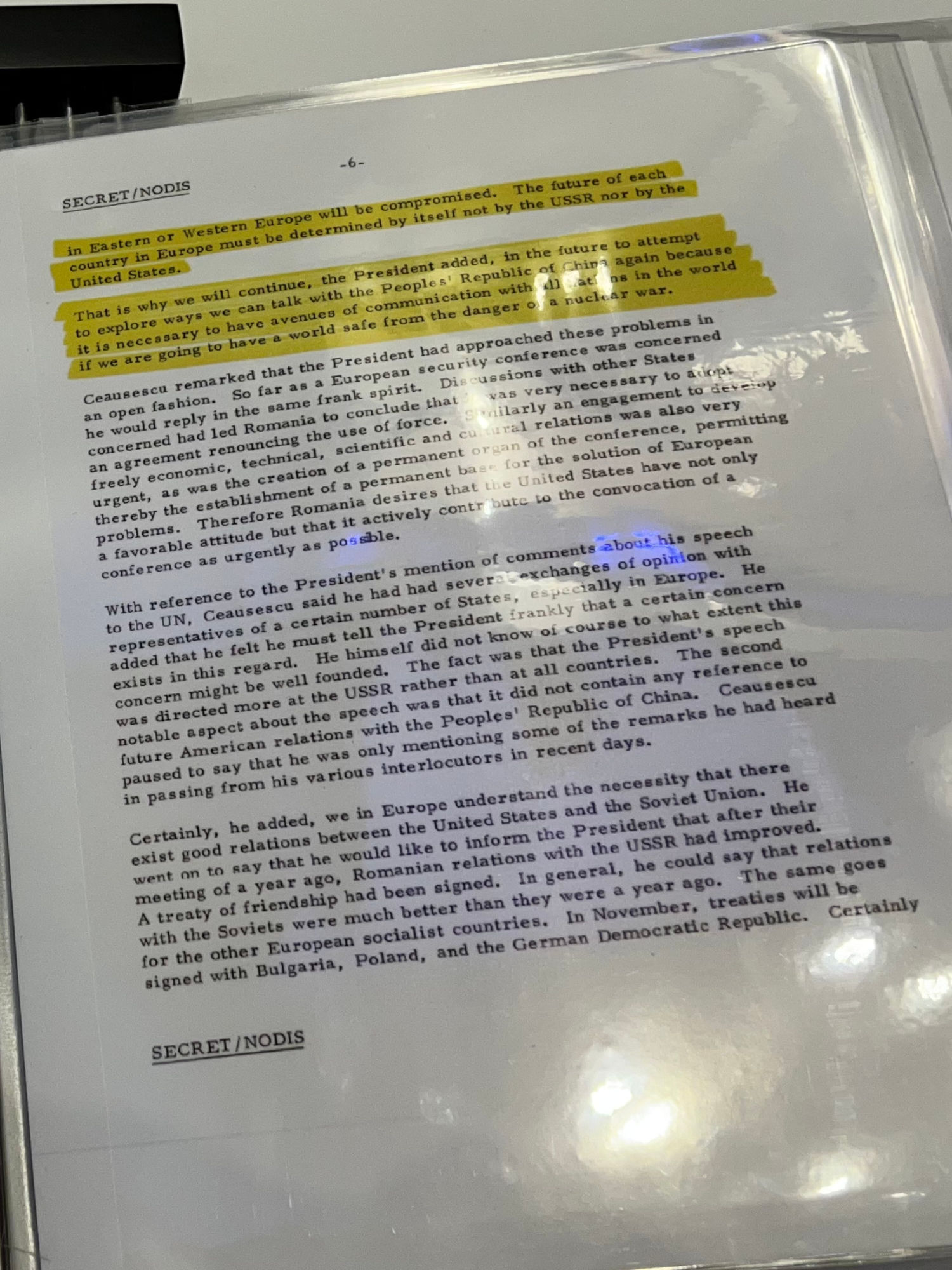

Romania
...
The discussion then moved to the question of relations with China. The President said that he wished to express appreciation for the fact that since his last meeting with Ceausescu the Romanian government had conveyed American views to the effect that the United States would like to start discussions with China. ...
The President responded by saying that, as Ceausescu knew, this was a problem which was very difficult for the United States because of our ties with the Chinese Nationalist government. The President stated his belief that there must be preliminary steps. One has to begin somewhere. A start cannot be made at the highest level of action. The United States is ready to have discussions on other subjects with the Peoples' Republic of China whenever they are ready.
...


Romania
...
The President stated that American policy is one of wanting friendly relations with both the USSR and eventually with Communist China. We do not intend to play one against another. Our desire is to have independent relations with each, not directed against the other. The President added that this seems to be President Ceausescu's viewpoint as well. He then remarked that President Ceausescu's continued role as a peacemaker is very useful in regard to U.S. - Chinese relations. He can talk to both parties which is very helpful and in the end, in the President's opinion, this will produce results.
...
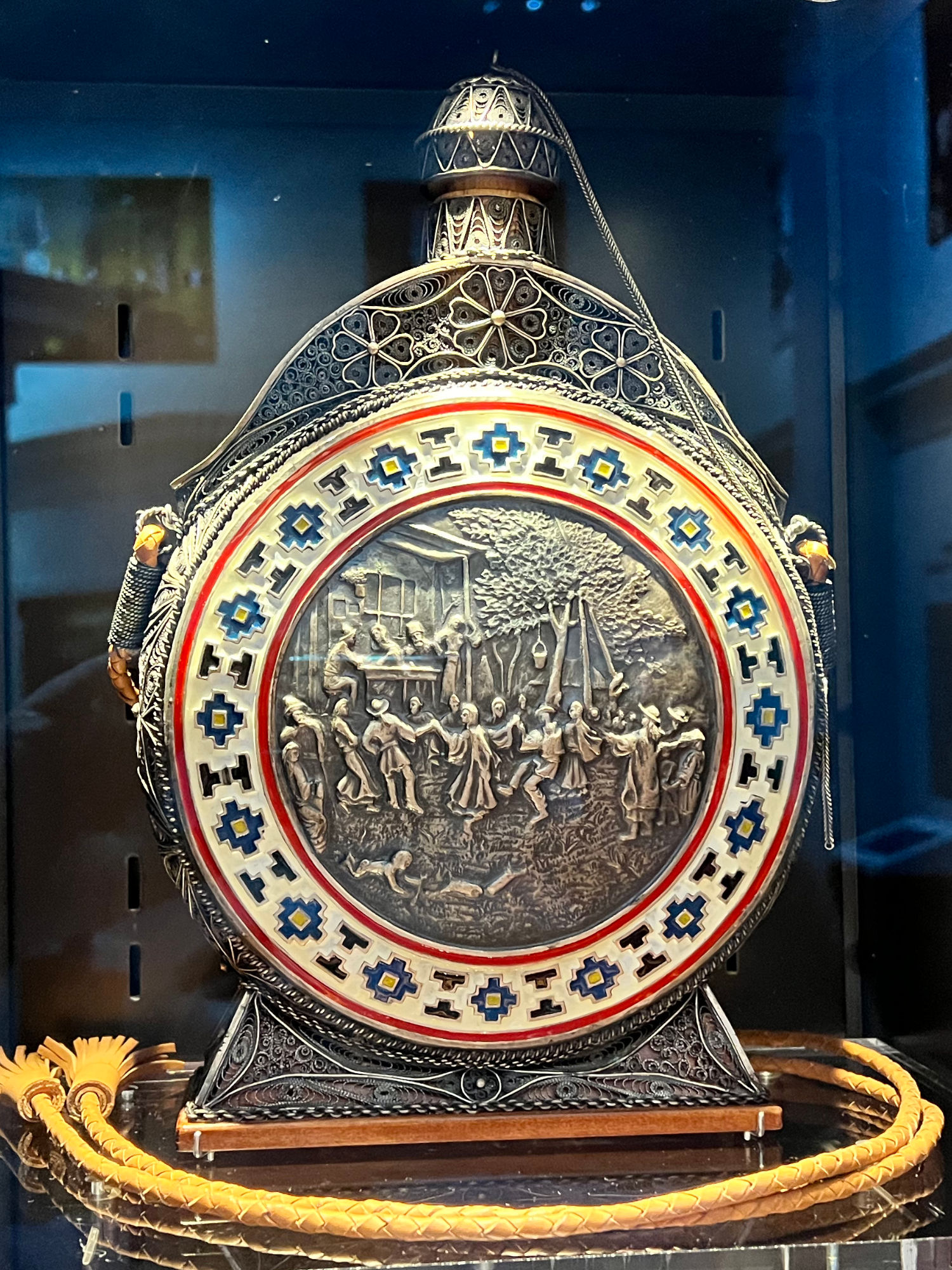
Romania
Wood flagon with silver filigree overlay
- One of the gifts presented to President and Mrs. Nixon by President Nicolae Causescu during the Romanian leader's 1970 visit to the White House.
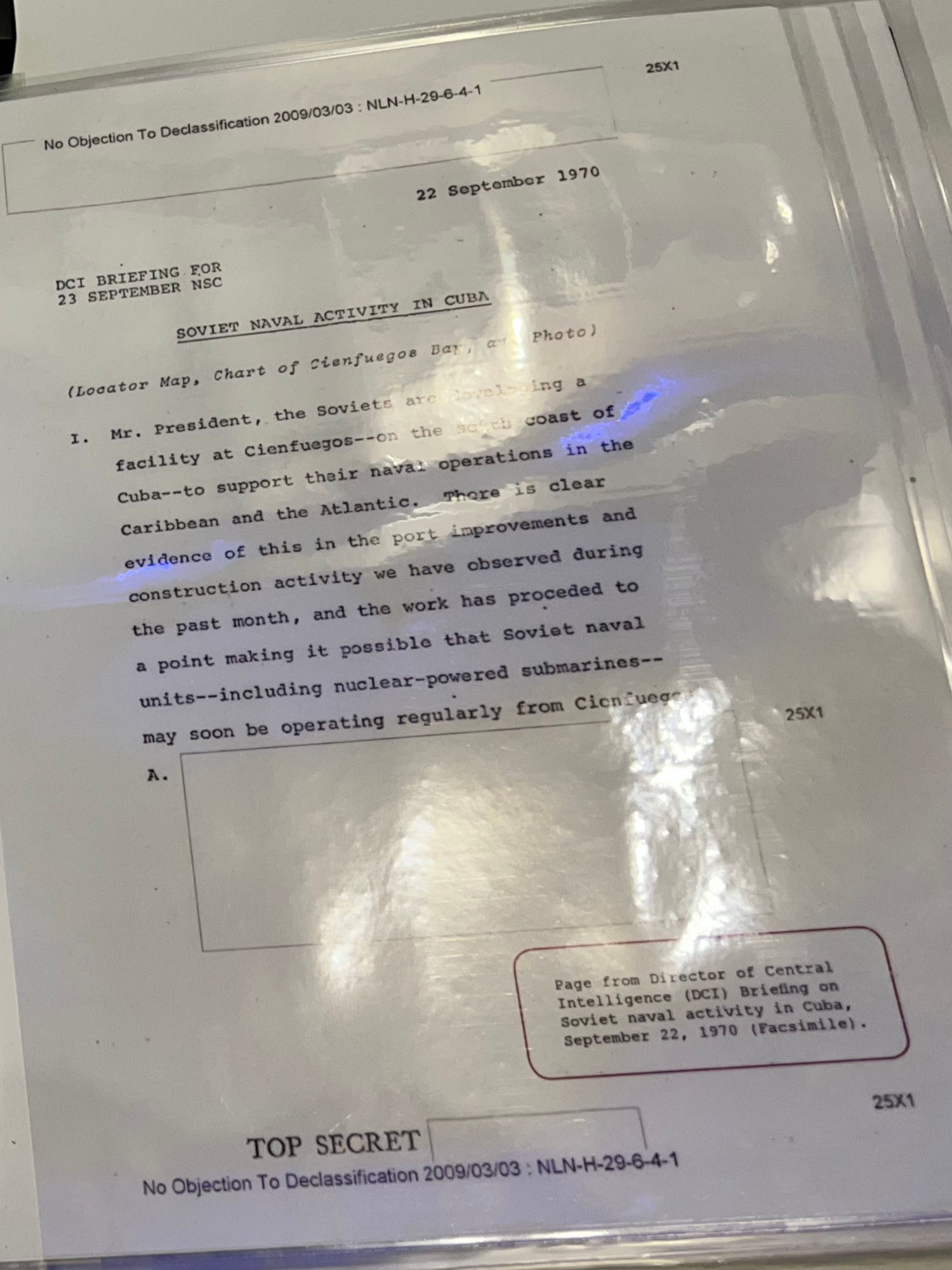
Soviet Naval Base in Cuba?
- Page from Director of Central Intelligence Briefing on Soviet naval activity in Cuba, September 22, 1970 (Facsimile).
These pages trace the U.S. discovery of Soviet action toward building a facility for submarines with nuclear and conventional missile capabilities at the Cienfuegos naval base, the Soviet denial, and possible approaches considered for U.S. response.

Soviet Naval Base in Cuba?
- Cable from Moscow, October 12, 1970, denying that the Soviet Union was building a military base in Cuba (Facsimile)
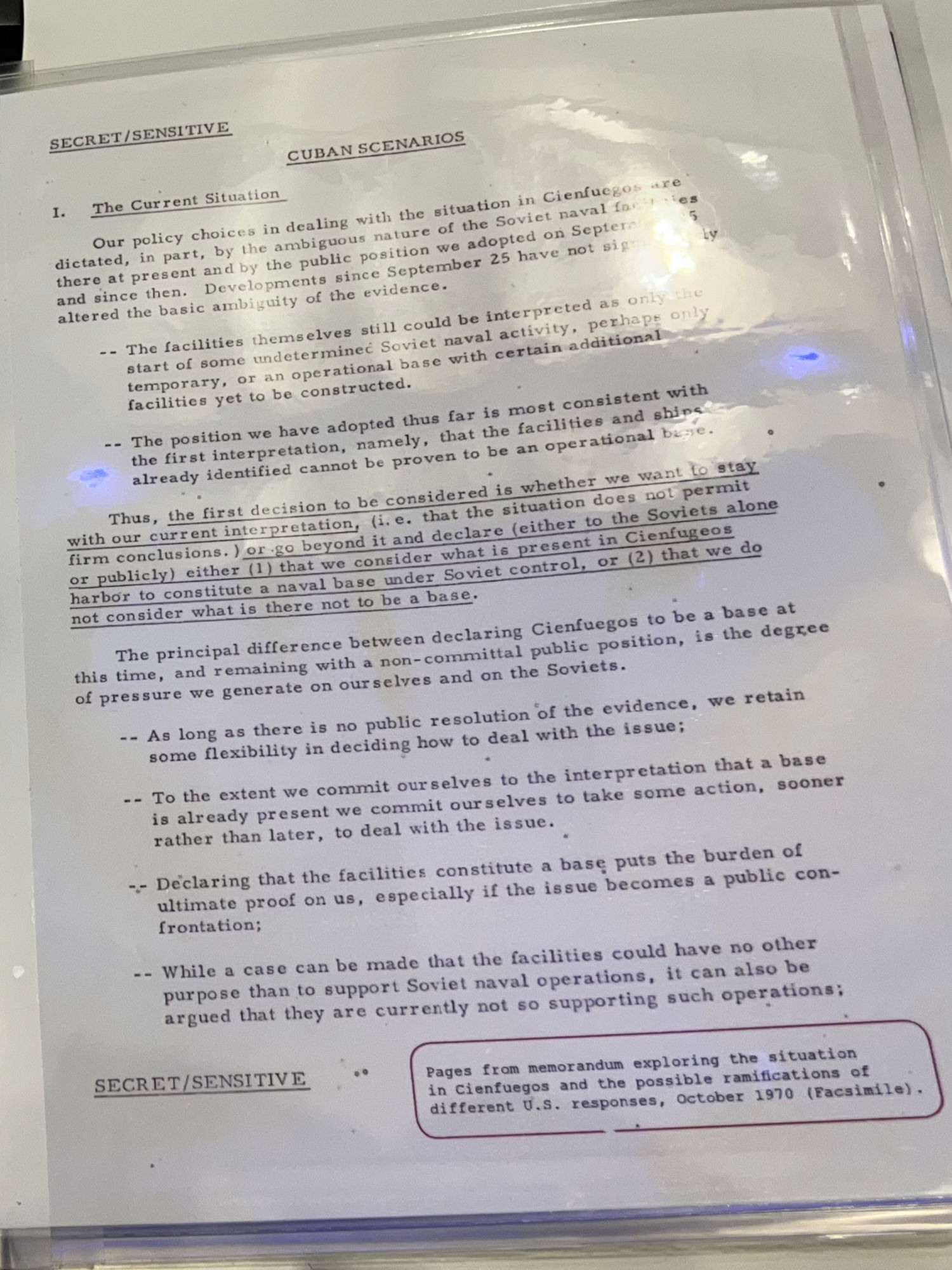
Soviet Naval Base in Cuba?
- Pages from memorandum exploring the situation in Cienfuegos and the possible ramifications of different U.S. responses, October 1970 (Facsimile).
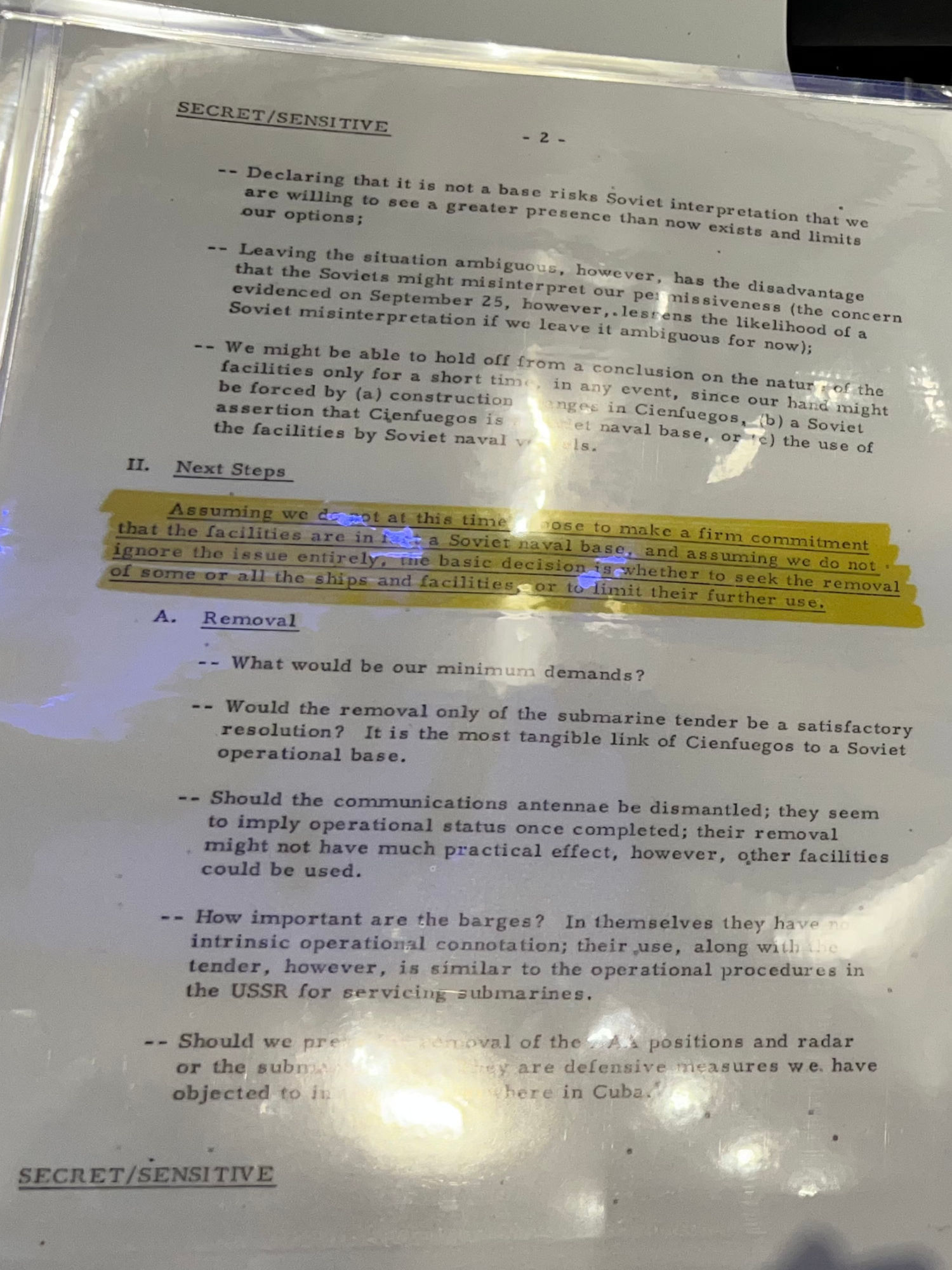
Soviet Naval Base in Cuba?
...
Assuming we do not at this time pose to make a firm commitment that the facilities are in fact a Soviet naval base, and assuming we do not ignore the issue entirely, the basic decision is whether to seek the removal of some or all the ships and facilities, or to limit their further use.
...
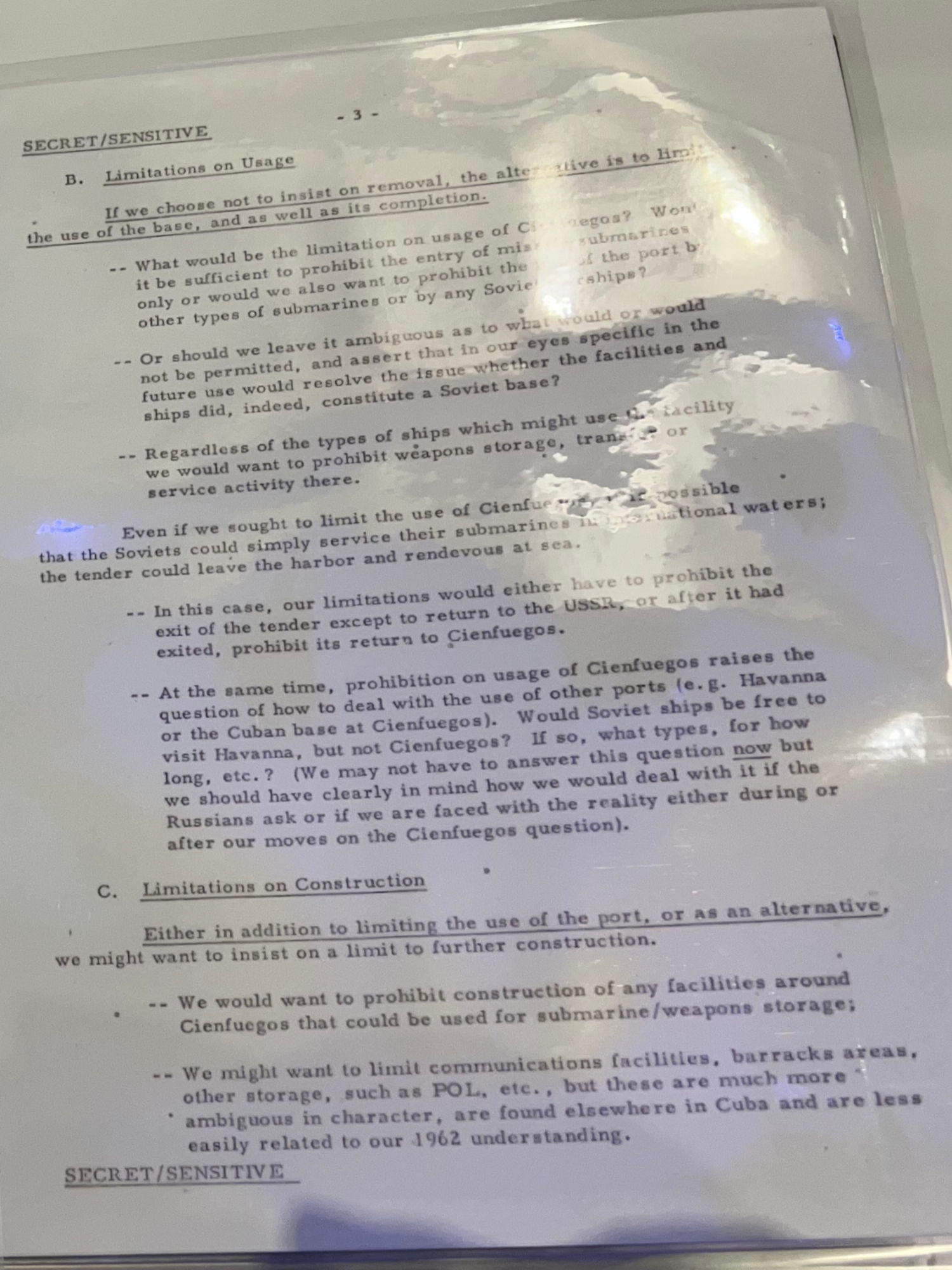
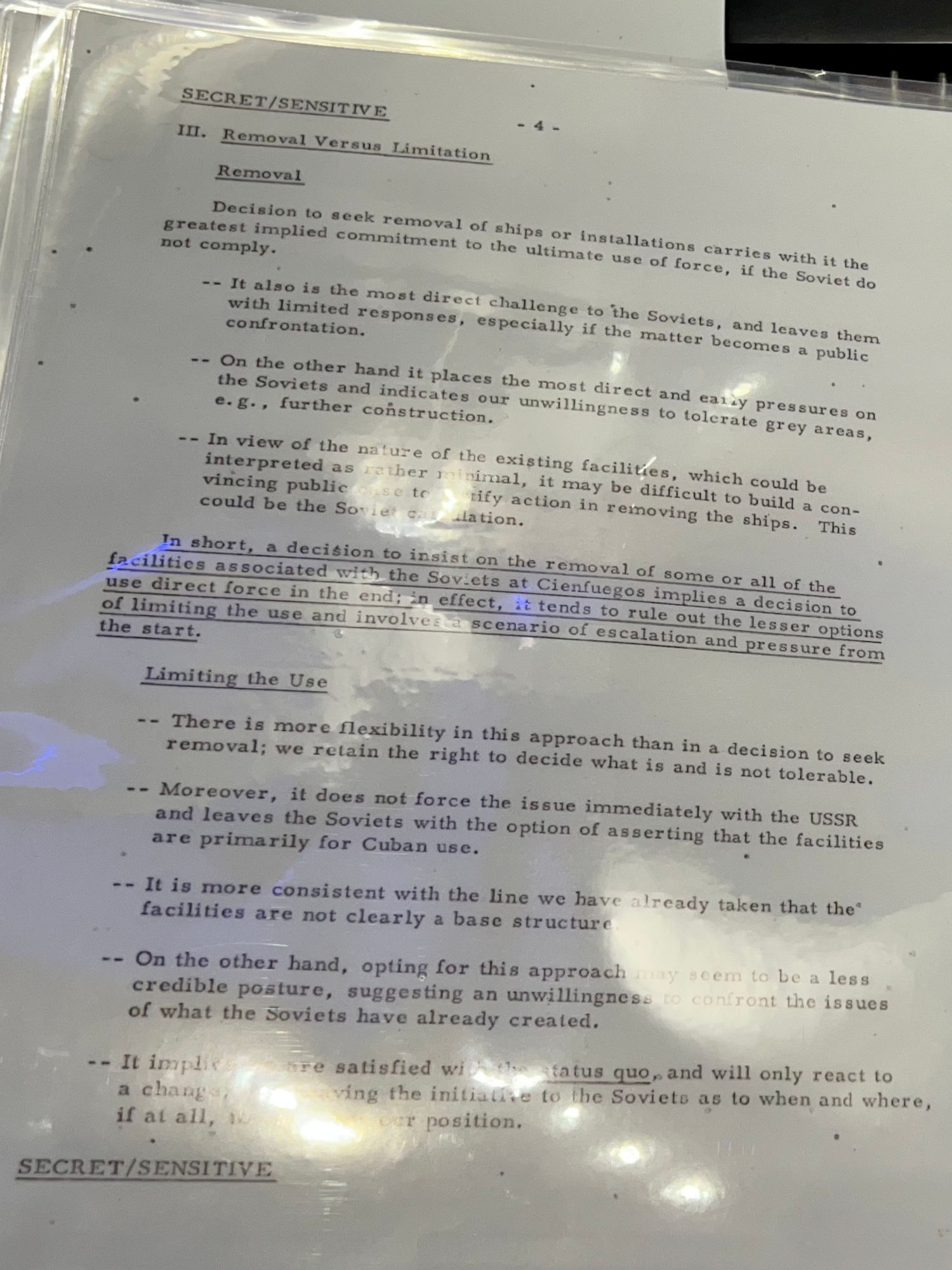
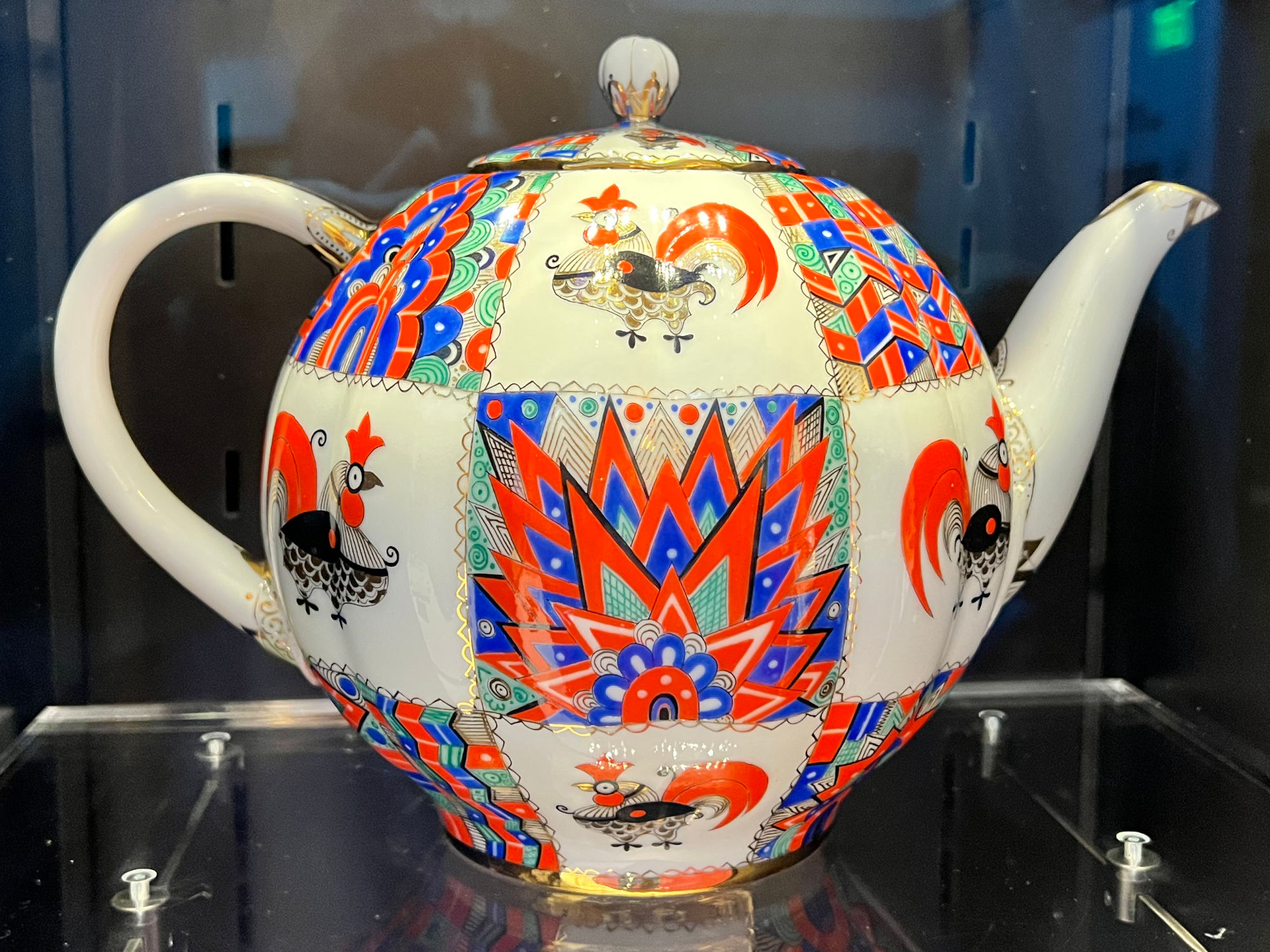
Soviet Union
Coffee pot
- Part of 33-piece coffee service accepted on behalf of the people of the United States by First Lady Pat Nixon as a gift from Soviet Premier Brezhnev on his 1973 visit.

The Berlin Wall
The greatest challenge in Eastern Europe - more difficult than tearing down the Berlin Wall - is to help build new systems that will not dash the euphoric expectations of those who risked so much in supporting the revolution. - 1990
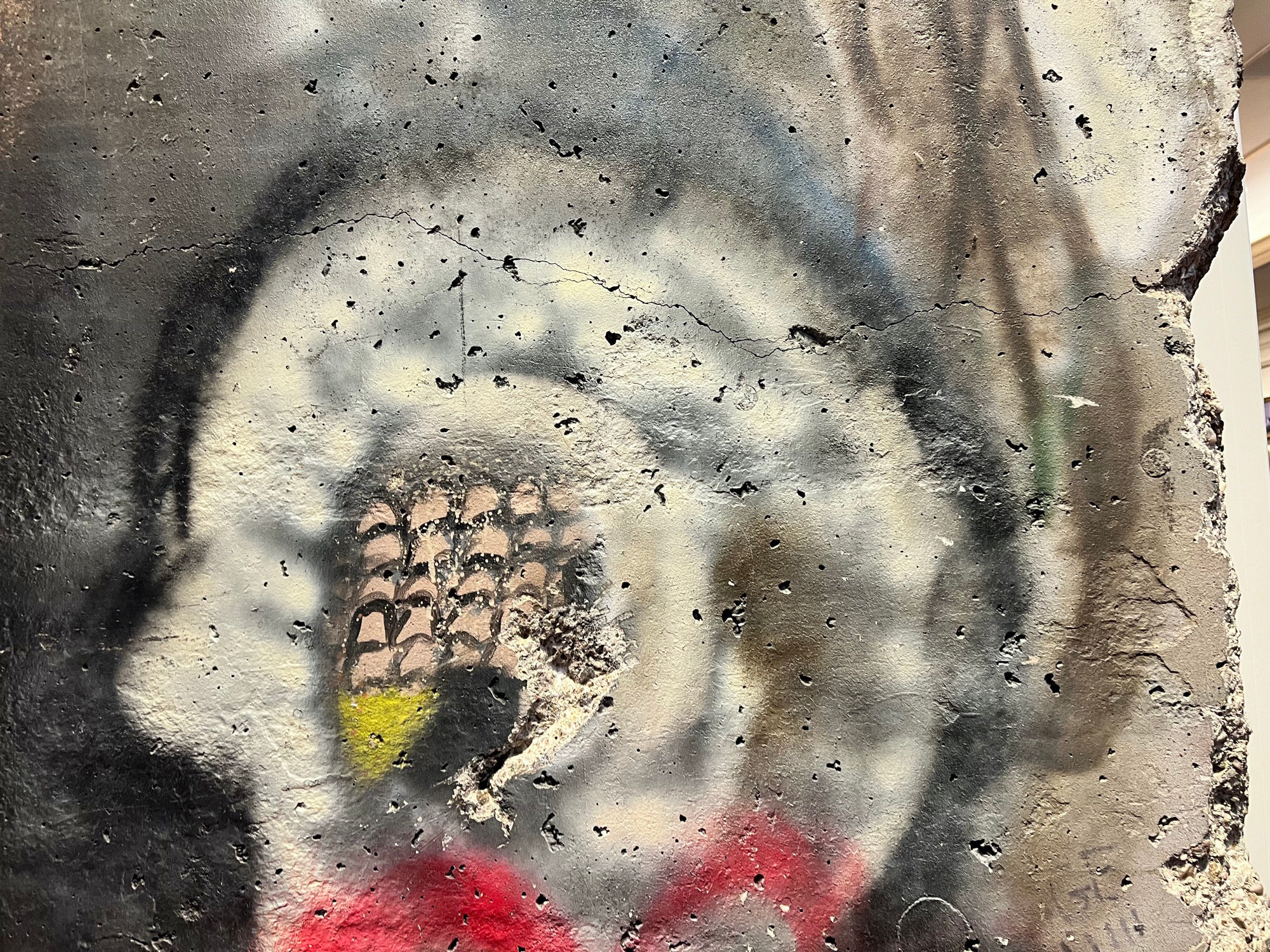
The Berlin Wall
The Berlin Wall, built in 1961, symbolized the Iron Curtain that cut Eastern Europeans off from the West. The wall separated the grim Soviet-controlled East Berlin from the democratic and thriving West Berlin. Families and friends woke up to find themselves divided by the barrier.
The wall - more than 90 miles of concrete and barbed wire - had closely guarded crossings, and desperate East Berliners were shot and killed in their efforts to reach the West.
President Nixon's policy of detente and the signing of the Strategic Arms Limitation Treaty created the first cracks in this formidable barrier, which would finally be torn down in 1989.
